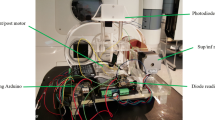Abstract
A commercially available motion phantom (QUASAR, Modus Medical) was modified for programmable motion control with the aim of reproducing patient respiratory motion in one dimension in both the anterior–posterior and superior–inferior directions, as well as, providing controllable breath-hold and sinusoidal patterns for the testing of radiotherapy gating systems. In order to simulate realistic patient motion, the DC motor was replaced by a stepper motor. A separate ‘chest-wall’ motion platform was also designed to accommodate a variety of surrogate marker systems. The platform employs a second stepper motor that allows for the decoupling of the chest-wall and insert motion. The platform’s accuracy was tested by replicating patient traces recorded with the Varian real-time position management (RPM) system and comparing the motion platform’s recorded motion trace with the original patient data. Six lung cancer patient traces recorded with the RPM system were uploaded to the motion platform’s in-house control software and subsequently replicated through the phantom motion platform. The phantom’s motion profile was recorded with the RPM system and compared to the original patient data. Sinusoidal and breath-hold patterns were simulated with the motion platform and recorded with the RPM system to verify the systems potential for routine quality assurance of commercial radiotherapy gating systems. There was good correlation between replicated and actual patient data (P 0.003). Mean differences between the location of maxima in replicated and patient data-sets for six patients amounted to 0.034 cm with the corresponding minima mean equal to 0.010 cm. The upgraded motion phantom was found to replicate patient motion accurately as well as provide useful test patterns to aid in the quality assurance of motion management methods and technologies.








Similar content being viewed by others
Reference
AIHW (2008) Cancer in Australia: an overview, in 2008 Cancer series. AIHW, Canberra
Keall PJ et al (2006) The management of respiratory motion in radiation oncology report of AAPM Task Group 76. Med Phys 33(10):3874–3900
Langen KM, Jones DT (2001) Organ motion and its management. Int J Radiat Oncol Biol Phys 50(1):265–278
ICRU, Prescribing, recording and reporting photon beam therapy (Supplement to ICRU Report 50), in ICRU Report No 62. 1999, International Commission on Radiation Units and Measurements Bethesda
Remouchamps VM et al (2003) Initial clinical experience with moderate deep-inspiration breath hold using an active breathing control device in the treatment of patients with left-sided breast cancer using external beam radiation therapy. Int J Radiat Oncol Biol Phys 56(3):704–715
Remouchamps VM et al (2003) Three-dimensional evaluation of intra- and interfraction immobilization of lung and chest wall using active breathing control: a reproducibility study with breast cancer patients. Int J Radiat Oncol Biol Phys 57(4):968–978
McNair HA et al (2009) Feasibility of the use of the active breathing Co ordinator (ABC) in patients receiving radical radiotherapy for non-small cell lung cancer (NSCLC). Radiother Oncol 93(3):424–429
Hanley J et al (1999) Deep inspiration breath-hold technique for lung tumors: the potential value of target immobilization and reduced lung density in dose escalation. Int J Radiat Oncol Biol Phys 45(3):603–611
Rosenzweig KE et al (2000) The deep inspiration breath-hold technique in the treatment of inoperable non-small-cell lung cancer. Int J Radiat Oncol Biol Phys 48(1):81–87
Wu H et al (2008) Gating based on internal/external signals with dynamic correlation updates. Phys Med Biol 53(24):7137–7150
Wink NM et al (2008) Individualized gating windows based on four-dimensional CT information for respiration-gated radiotherapy. Phys Med Biol 53(1):165–175
Vedam SS et al (2001) Determining parameters for respiration-gated radiotherapy. Med Phys 28(10):2139–2146
Keall PJ et al (2002) Potential radiotherapy improvements with respiratory gating. Australas Phys Eng Sci Med 25(1):1–6
Zimmerman J et al (2009) DMLC motion tracking of moving targets for intensity modulated arc therapy treatment: a feasibility study. Acta Oncol 48(2):245–250
Keall PJ et al (2005) Four-dimensional radiotherapy planning for DMLC-based respiratory motion tracking. Med Phys 32(4):942–951
McQuaid D, Webb S (2006) IMRT delivery to a moving target by dynamic MLC tracking: delivery for targets moving in two dimensions in the beam’s eye view. Phys Med Biol 51(19):4819–4839
Lujan AE et al (1999) A method for incorporating organ motion due to breathing into 3D dose calculations. Med Phys 26(5):715–720
Ionascu D et al (2007) Internal-external correlation investigations of respiratory induced motion of lung tumors. Med Phys 34(10):3893–3903
Berbeco RI et al (2005) Residual motion of lung tumours in gated radiotherapy with external respiratory surrogates. Phys Med Biol 50(16):3655–3667
Cervino LI et al (2009) The diaphragm as an anatomic surrogate for lung tumor motion. Phys Med Biol 54(11):3529–3541
Yan H et al (2008) The investigation on the location effect of external markers in respiratory-gated radiotherapy. J Appl Clin Med Phys 9(2):2758
Thomas JG et al (2009) Intra and interfraction mediastinal nodal region motion: implications for internal target volume expansions. Med Dosim 34(2):133–139
Acknowledgments
This study was supported by a scholarship from the RMIT University Health Innovations Research Institute.
Author information
Authors and Affiliations
Corresponding author
Rights and permissions
About this article
Cite this article
Dunn, L., Kron, T., Johnston, P.N. et al. A programmable motion phantom for quality assurance of motion management in radiotherapy. Australas Phys Eng Sci Med 35, 93–100 (2012). https://doi.org/10.1007/s13246-011-0114-0
Received:
Accepted:
Published:
Issue Date:
DOI: https://doi.org/10.1007/s13246-011-0114-0




